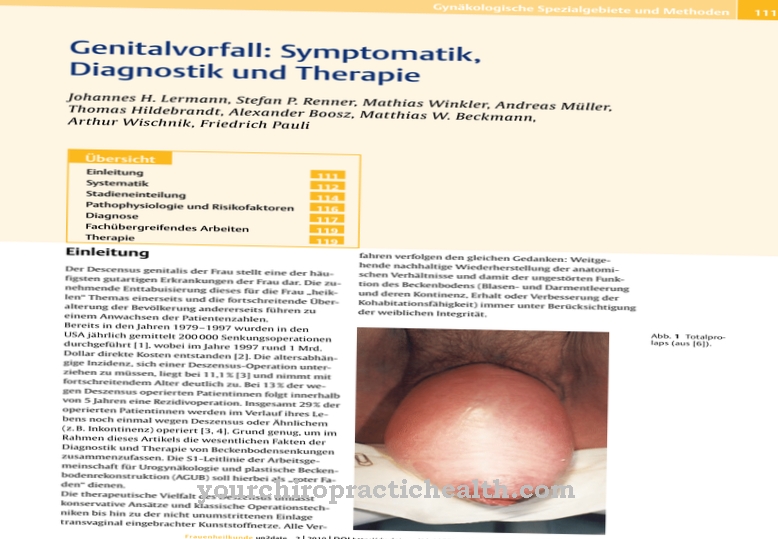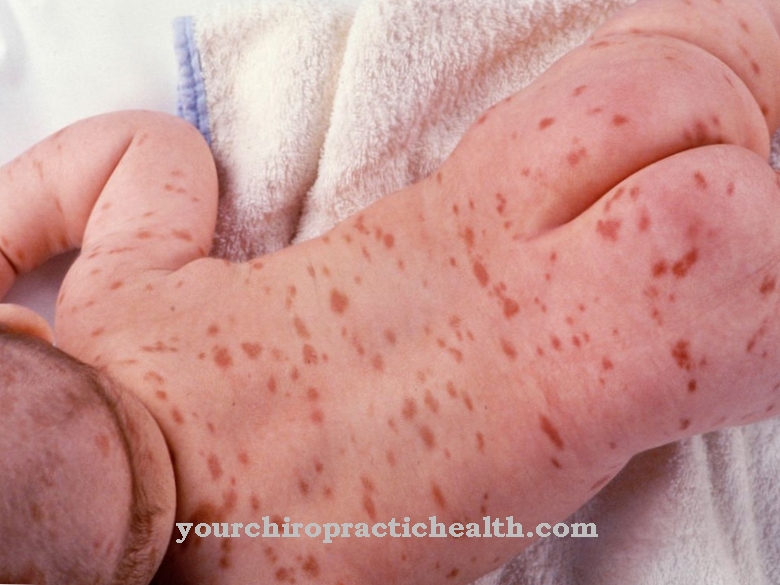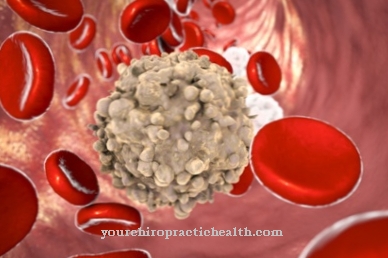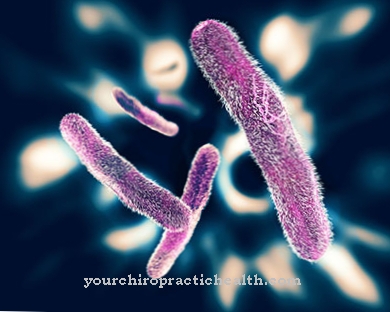The Thromboembolism is caused by a blood clot that has been dragged into the bloodstream. It leads to the closure of the affected blood vessel, which can then no longer supply the corresponding organs. If left untreated, thromboembolism can be fatal.
What is thromboembolism?

© logo3in1 - stock.adobe.com
A Thromboembolism is characterized by a blood clot that can move freely in the bloodstream and that can completely close the corresponding blood vessel. It always arises from an existing thrombosis through mechanical detachment of a thrombus. There are both venous and arterial thromboembolisms.
In most cases, it is a venous embolism that originates from a thrombosis of the deep veins in the leg. In this case, the thrombus always moves towards the lungs and can trigger a pulmonary embolism. Arterial thromboembolism is based on arterial thrombosis in the arteries. If a thrombus loosens here, peripheral organs such as the brain, heart, eye, kidney or intestine are affected by an embolism.
The oxygen supply to these organs is interrupted or greatly reduced, so that certain parts of the organs can partially die off. Heart attacks, strokes, retinal infarcts (eye) or mesenteric infarcts (intestinal infarction) occur.
Often times, thromboembolism develops suddenly out of the blue and with no prior symptoms. Only in the case of extensive thrombosis are there symptoms that can be traced back to circulatory disorders in important veins or arteries.
causes
The prerequisite for a thromboembolism is always the presence of a thrombosis. This is a vascular disease that leads to the formation of a blood clot. The deep veins in the legs are most affected by thrombosis. The same causes can also cause thromboses in the arm veins or various arteries (arteries).
When speaking of thrombosis, however, it usually refers to the formation of thrombi in the leg veins. Overall, three main factors are responsible for the development of thrombosis. These include damage to the vessel wall, reduced blood flow velocity and its changed viscosity. The vessel walls can be damaged by chronic inflammation.
Diabetes, arteriosclerosis, autoimmune reactions and smoking pose great risks for inflammatory processes in the vessels. This creates rough spots on the vessel walls, on which smaller blood clots adhere, which normally form constantly in the blood. Other thrombi accumulate on these established thrombi until the blood vessel closes completely or a thrombus in the form of a thromboembolism is flushed through the bloodstream.
A change in the flow velocity takes place, among other things, in places where turbulence can occur. In the case of arteries, for example, this occurs when larger arteries are divided into several smaller arteries. But the flow of blood is also impeded in varicose veins or on aneurysms. Thrombi often form there too, especially after lying down for a long time or having an unusual leg position when traveling by bus or plane.
Overturning your legs can also disrupt blood flow. If the blood flow slows down due to thickening of the blood, such as dehydration, thrombosis can also develop. Regardless of these causes, there are also genetically determined blood clotting disorders that can lead to increased blood clotting and thus increase the risk of thrombosis.
Symptoms, ailments & signs
Venous thromboembolism usually causes pulmonary embolism, which can also be fatal. Blood clots from the deep leg veins enter the pulmonary arteries and block them. When the blood flow is almost completely interrupted, hardly any blood can get into the left ventricle. This endangers the oxygen supply to many organs of the body.
Symptoms include sudden shortness of breath, cardiac arrhythmias, coughing up blood, leg swelling, chest pain and, in very severe cases, cardiac arrest. Smaller pulmonary embolisms can be asymptomatic, but over a long period of time they lead to chronic pulmonary hypertension and heart failure.
Arterial thromboembolism affects individual organs. Circulatory disorders caused by blood clots can cause infarctions of the heart, brain (stroke), eyes, kidneys or intestines. The symptoms depend on the organ affected.
Diagnosis & course of disease
Thrombosis can be diagnosed, among other things, by doing blood tests for D-dimers. These are decomposition products of thrombi. However, this test is not specific enough to be used as unequivocal evidence of a thrombosis. However, a venous thrombosis is now detected via an ultrasound examination and confirmed via an X-ray examination with contrast media.
Complications
Thromboembolism is a dangerous condition and can have very serious complications. If the patient has survived a thrombosis, a partially or even completely blocked vein is often left behind, which can lead to blood backlogging in the affected limbs. In the long term, the increased venous pressure often causes the development of varicose veins as well as swellings and skin changes on the lower leg, which can turn brown.
The formation of ulcers in the ankle area is also possible. These side effects are known as post-thrombotic syndrome and can affect the patient's quality of life. The risk of such a development also exists if a blood clot is slowly broken down by the body, but the sensitive venous valves are destroyed during this process.
In these cases, the blood flow back to the heart is only possible when lying down. In contrast, when sitting and especially when standing, the blood sinks back into the legs. Depending on how severe the venous valve damage is, the affected limbs regularly swell significantly during the day. Edema forms.
Such complications are to be expected especially if the patient does not take the thromboembolism seriously or if it is not treated properly by a doctor for other reasons. The worst complication that can be associated with deep vein thrombosis is pulmonary embolism. In this case, a sudden cardiac arrest with fatal consequences threatens.
When should you go to the doctor?
A thromboembolism is a medical emergency. An ambulance service is required to ensure the survival of the person affected. A doctor must be called in the event of irregular heartbeat, sudden shortness of breath or pain in the chest. If there is swelling of the limbs, bloody sputum or internal weakness, there is an urgent need for action. In the event of a thromboembolism, those present must react quickly and professionally. First aid measures are necessary to ensure the survival of the person affected.
Blood circulation disorders, cramps or impairment of physical functions indicate a health irregularity. Discoloration of the skin, the formation of varicose veins and restrictions on mobility must be examined and treated. If sporting or everyday obligations can no longer be fulfilled as usual, there is already a need for action. These are warning signals from the organism that should be followed up. Sensitivity disorders, headaches or circulatory irregularities should be examined and treated.
Memory irregularities, palpitations or unsteady gait also indicate a health disagreement in the early stages of the disease. A feeling of internal heaviness, muscle disorders, or general malaise should be presented to a doctor. Further examinations are needed to enable a diagnosis to be made.
Treatment & Therapy
In many cases, pulmonary embolism requires emergency life-saving treatment. Adequate ventilation must be provided for this. At the same time, anticoagulants such as heparin, warfarin or phenprocoumon must be given. If symptoms of shock occur, the circulation must be stabilized.
Furthermore, in acute cases, the thrombi are dissolved as part of a lysis therapy (dissolution by enzymes) or destroyed by mechanical shattering using catheter technology. Even after acute treatment, the anticoagulants should be administered for a few months or, in special cases, for life. Lysis therapy, reopening of blood vessels using catheter technology or thrombectomy (surgical removal of the thrombus) are also used in arterial thromboembolism.
prevention
A healthy lifestyle can prevent thromboembolism. This reduces the risk factors of diabetes, disorders of lipid metabolism and arteriosclerosis. A healthy lifestyle includes a balanced diet, plenty of exercise, abstaining from smoking and alcohol, and avoiding stress and being overweight.
After operations or accidents, rapid mobilization should be aimed for in order to keep the risk of thrombus formation as low as possible. In the presence of coagulation disorders, the administration of clopidogrel or acetylsalicylic acid has proven effective in preventing arterial thromboembolism.
You can do that yourself
The most important point is to avoid congestion of blood. A balanced diet and exercise are particularly helpful here. Those affected should walk for at least 30 minutes a day, and at least five times a week. In addition, you should get up for ten minutes every two to three hours and walk a bit, especially when doing sedentary work. We also recommend activities such as swimming, cycling or light jogging several times a week.
Simple foot and leg exercises for 15 minutes every morning can also help. However, the right diet can also help those affected. Especially foods with plenty of vitamin E are recommended. Vitamin E contains anticoagulant properties. These will help prevent blood clots. The vitamin inhibits platelet aggregation and thus combats the effects of coagulation factors. Ginger also plays an important role. Containing a natural salicylate, it can block vitamin K, which thins the blood. It also promotes blood circulation in the vessels.
In addition, it is advisable to prevent high cholesterol levels. Because these cause plaque buildup and thus inhibit blood flow. The active ingredient capsaicin, which is contained in cayenne pepper, also promotes blood circulation. It strengthens the capillaries and arteries. Another great natural remedy is apple cider vinegar. This improves blood circulation and blood flow and thus reduces the clotting of the blood.



.jpg)









.jpg)

.jpg)
.jpg)











.jpg)